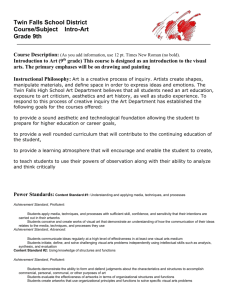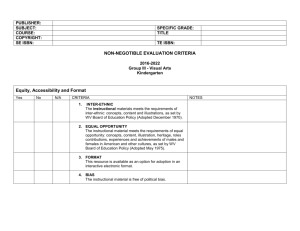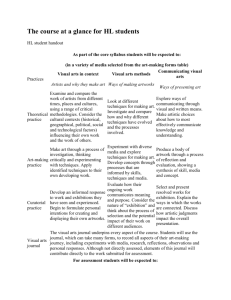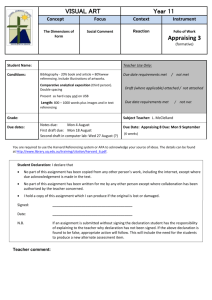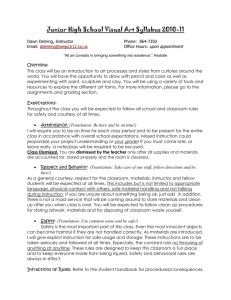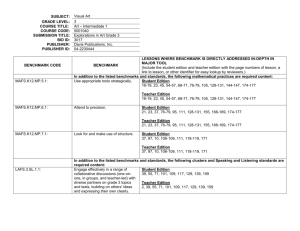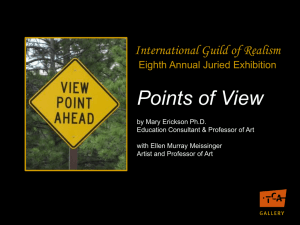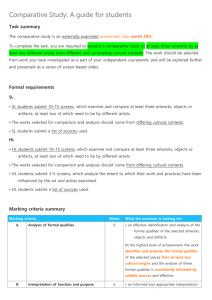YEAR 15 16 Opening Letters Syllabus
advertisement
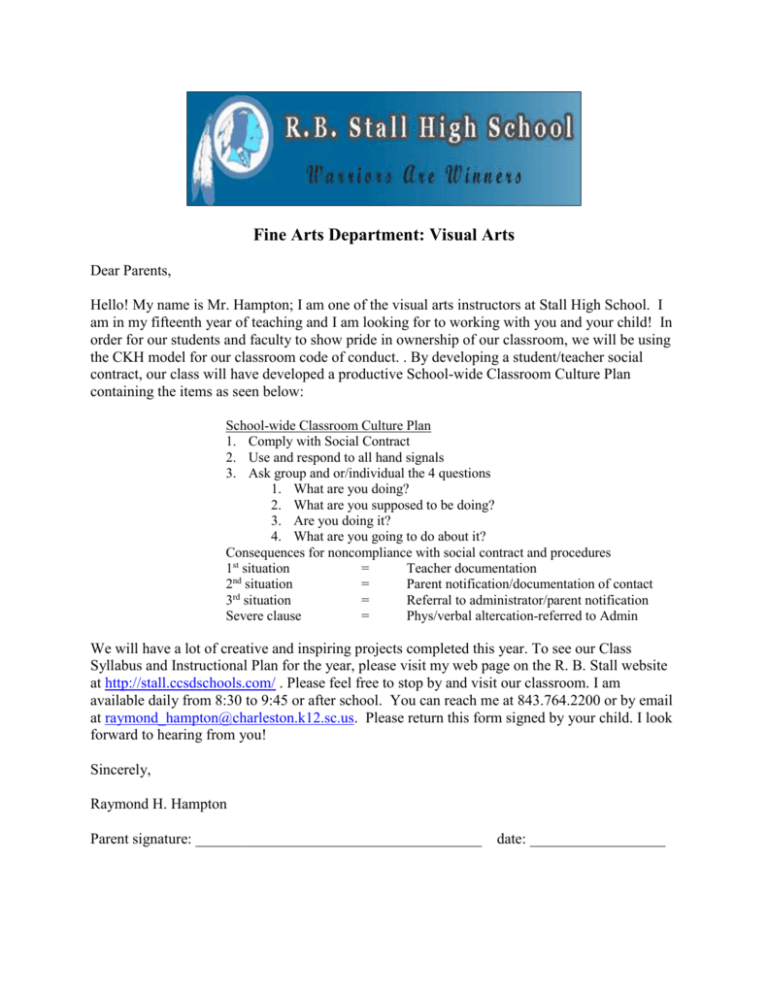
Fine Arts Department: Visual Arts Dear Parents, Hello! My name is Mr. Hampton; I am one of the visual arts instructors at Stall High School. I am in my fifteenth year of teaching and I am looking for to working with you and your child! In order for our students and faculty to show pride in ownership of our classroom, we will be using the CKH model for our classroom code of conduct. . By developing a student/teacher social contract, our class will have developed a productive School-wide Classroom Culture Plan containing the items as seen below: School-wide Classroom Culture Plan 1. Comply with Social Contract 2. Use and respond to all hand signals 3. Ask group and or/individual the 4 questions 1. What are you doing? 2. What are you supposed to be doing? 3. Are you doing it? 4. What are you going to do about it? Consequences for noncompliance with social contract and procedures 1st situation = Teacher documentation 2nd situation = Parent notification/documentation of contact 3rd situation = Referral to administrator/parent notification Severe clause = Phys/verbal altercation-referred to Admin We will have a lot of creative and inspiring projects completed this year. To see our Class Syllabus and Instructional Plan for the year, please visit my web page on the R. B. Stall website at http://stall.ccsdschools.com/ . Please feel free to stop by and visit our classroom. I am available daily from 8:30 to 9:45 or after school. You can reach me at 843.764.2200 or by email at raymond_hampton@charleston.k12.sc.us. Please return this form signed by your child. I look forward to hearing from you! Sincerely, Raymond H. Hampton Parent signature: ______________________________________ date: __________________ Art – I: Units of Instruction: The following units incorporate all of the Visual Arts Standards: Unit I – Weeks 1-2 Classroom introduction Introduction to drawing: Intro Exercises Unit 2- Weeks 3-4 Painting A. Preparation and Procedures B. Introduction to Painting/ Art and History A look at the SC Artist: Harlem Renaissance Artist: William H. Johnson Unit 3- Weeks 5-7 Drawing A. Ad Reproduction B. Portraits Unit 4- Weeks 8-10 3-D Sculpture Wall Murals Unit 5- Weeks 11-12 Painting A. Pop Art Unit 6- Weeks 13- 16 3D Art: Intro to Slab-hand building techniques A: Glazing/firing techniques-aesthetics B: Cultural Masks Unit 7- Week 15-16 Painting A. Landscapes Unit 8- Week 17 Mixed Media A. Student choice Unit 9- Week 18 Finishing Week A. Exam review B. Student project(s) completion Sculpture I: Units of Instruction: The following units incorporate all of the Visual Arts Standards: Unit I – Weeks 1-2 Introduction to Ceramics A. Classroom procedures B. Introduction to clay/ clay tools –preparation and procedures C. Pinch Pots D. Coil Pots E. Glazing/firing techniques-aesthetics Unit 2- Weeks 3-5 Art for a social cause: 3D Art Installation A. Artists review B. Group Project Unit 3- Weeks 6-7 Hand building A. Utilitarian B. Student Choice Unit 4- Weeks 8-9 Slab-hand building techniques A. Historical SC architecture tiles B. Vases Unit 5- Weeks 10-11 Ceramic Designs A. Tea Pots Unit 6- Weeks 12- 13 A. Ornaments Unit 7- Week 14-15 Painting/Clay A. Murals Unit 8- Week 16-17 A. Student choice Unit 9- Week 18 Finishing Week A. Exam review/Student project(s) completion B. Comprehensive Exam Sculpture II: Units of Instruction: The following units incorporate all of the Visual Arts Standards: Unit 1- week 1-2 Clay introduction A. Classroom procedures B. Introduction to various clay types C. Joined pinch pot D. Advanced coil pot Unit 2- week 3-5 Hand building A. Wind chimes B. Façade- Architectural Unit 3- week 6-8 Sculpture introduction A. Introduction to Artists B. Techniques-Method C. People Unit 4-week 9-10 Abstract Art and Clay A. Artists study B. Students design/project Unit 5-week 11-13 Utilitarian A. Architectural Cookies Jars Unit 6-week 14 Student Choice A. Student sketch/design B. Student project Unit 7-week 15-17 Portrait Sculpting The influences of Auguste Rodin Auguste Rodin vs. modern day A. Student response paper B. Project - emotional portrayal in clay Unit 9- Week 18 Finishing Week A. Exam review/Student project(s) completion B. Comprehensive Exam Student Assessments Student projects will be assessed through a teacher/student rubric which is introduced to the student at the beginning of each project so that students are aware of the expectations as well as learning goals to be achieved. Following the completion of each project the students will assess themselves while addressing the various visual art elements and principles of design that are in alignment with the South Carolina Visual Arts Standards. The students will also be responsible for keeping an electronic portfolio of their work/critiques in the classroom Edmodo account. In addition various quizzes will be given throughout the semester as well as a comprehensive final exam. Course Syllabus Art I Course # 3050110cw Room B 127 R.B. Stall High School R. H. Hampton, raymond_hampton@charleston.k12.sc.us.Visual Arts Instructor Course Description Art I is an introduction to the elements and principles of design. This course introduction will include both two-dimensional and 3-dimensional student created projects to help further enhance awareness in the visual arts through alignment with the South Carolina Visual Arts Standards Instructional Philosophy The teacher will utilize such learning strategies as individualized instruction and re-teaching (when needed), small group instruction, peer teaching, hands-on applications and brainstorming to name a few, to incorporate learning thru the South Carolina Visual and Performing Arts curriculum standards as well as Common Core State Standards from English Language Arts and Math Power Standards All standards for the South Carolina Visual Arts are considered power standards and will be addressed individually or collectively throughout the semester. They are as follows: HIGH SCHOOL LEVEL 1 Standard H1-1 The student will demonstrate competency in and apply a variety of media, techniques, and processes. Students on the secondary level use a variety of media, techniques, and processes to create artworks in multiple art forms. Students are able to describe how different media, techniques, and processes cause different outcomes. Students use different media, techniques, and processes to communicate ideas and personal experiences. Students learn to use tools, materials, and equipment in a safe and responsible manner. When offered a variety of media, techniques, and processes, students will select the media, techniques, and processes that best meet the needs of their intentions to communicate ideas and personal experiences. Indicators VAH1-1.1 Recognize and analyze the similarities and differences between media, techniques, and processes in multiple art forms. VAH1-1.2 Describe how different media, techniques, and processes have different outcomes that cause different viewer responses. VAH1-1.3 Communicate ideas through the effective use of a variety of media, techniques, and processes in multiple art forms. VAH1-1.4 Apply media, techniques, and processes with skill, confidence and sensitivity sufficient to make their intentions observable in their artworks. VAH1-1.5 Use a variety of art media, tools, and equipment in a skillful, safe, and responsible manner HIGH SCHOOL LEVEL 1 Standard H1-2 The student will use knowledge of composition and the elements and principles of design to communicate ideas. Students on the secondary level will recognize, describe and analyze the elements and principles of design in relation to the environment (man-made and natural) and the visual arts. Students will apply the elements and principles of design as well as other compositional structures and strategies to create artworks with intent and purpose. Indicators VAH1-2.1 Recognize, describe and analyze the elements and principles of design as well as other compositional structures and strategies used in the visual arts across a variety of art forms, art styles, and art movements. VAH1-2.2 Create artworks that effectively apply appropriate elements and principles of design and other compositional structures and strategies that solve specific visual arts problems. VAH1-2.3 Evaluate the effectiveness of artworks in relation to the application of elements and principles of design and other compositional structures and strategies HIGH SCHOOL LEVEL 1 Standard H1-3 The student will explore prospective content in artworks. Students on the secondary level explore the many possibilities of prospective content through the analysis of others’ artwork. Students will create artworks by choosing and using a variety of subject matter, symbols, and ideas. Indicators VAH1-3.1 Explore the prospective content for the creation of artworks in relation to subject matter, symbols, and ideas from a variety of art forms, art styles, and art movements. VAH1-3.2 Analyze and describe the relationship among subject matter, symbols, and themes in communicating intended meaning in their artworks and the works of others. VAH1-3.3 Select and effectively use subject matter, symbols, and ideas to communicate meaning in their artwork. HIGH SCHOOL LEVEL 1 Standard H1-4 The student will demonstrate competency in their use of the visual arts in relation to history, various cultures, and technologies. The use of cultural and historical exemplars in the art classroom along with discussion of the work of artists from different time periods in relation to the tools and technology available to them will help students begin to understand the impact time, culture, and technology have on artworks. In addition, the impact of the visual arts on shaping cultures is addressed with inclusion of visual literacy’s effect on contemporary culture. Indicators VAH1-4.1 Describe how subject matter, symbols, ideas, and technologies in various artworks are related to history and culture. VAH1-4.2 Identify specific artworks as belonging to a particular culture or time period and explain the characteristics that led to that identification. VAH1-4.3 Describe and discuss function and meaning of specific artworks from various world cultures and time periods. VAH1-4.4 Demonstrate competency in visual literacy by deconstructing images in a variety of contexts. VAH1-4.5 Apply knowledge of art history, various cultures, visual literacy, and technologies in the creation of original artworks. HIGH SCHOOL LEVEL 1 Standard H1-5 The student will analyze and assess the characteristics and qualities of their artworks and the artworks of others. The secondary level student will describe an artist’s focus or intentions in creating work, how their experiences influenced their work, and that people respond differently to the same artwork. Students will also be able express their intentions in the creation of artworks. Indicators VAH1-5.1 Analyze the intention of the artist in a specific artwork and justify their interpretation. VAH1-5.2 Make complex, descriptive, interpretative, and evaluative judgments about their own artworks and those of others. VAH1-5.3 Formulate criteria for interpreting and evaluating their artworks and those of others. VAH1-5.4 Maintain a personal portfolio of their artworks. HIGH SCHOOL LEVEL 1 Standard H1-6 The student will make connections between the visual arts, other arts disciplines, other content areas, and the world. Students are able to describe the characteristics of the visual arts in comparison to other disciplines in the school curriculum based on their experiences. In addition, students are able to describe the characteristics of different art forms, techniques, and technologies. Indicators VAH1-6.1 Analyze the similarities and differences in the visual arts and other arts disciplines. VAH1-6.2 Compare and contrast concepts, issues, and themes in the visual arts and other subjects in the school curriculum. VAH1-6.3 Identify specific visual arts careers and describe the knowledge and skills needed for these careers. Major Assessments and Grading Practices Projects will be graded with a teacher/student evaluation rubric. These rubrics will reflect what is expected for each project. Students will be asked to honestly critique (evaluate) their work in advance. Most evaluation ratings range from 1-5 (60-100%) and students are expected to create written statement to explain their ratings. Students are expected to use complete sentences and have proper grammar and punctuation. After student evaluation completion, students will submit the rubric to the teacher for final evaluation. Rubrics will vary with each project and project expectations (individual rubric guidelines) will be introduced at the beginning of each project. Student projects will be graded as tests. Final examinations will be a component of this course and will count 20% of the students’ final grade. Course Projects Projects may be altered or changed at any needed time to accomodate student/classroom needs. Unit I Classroom procedures Introduction to drawing Unit 2 Painting A. . Art and History Local Harlem Renaissance Artist William H. Johnson Unit 3 Drawing A. Grid drawing techniques: Ad Reproduction B. Portraits Unit 4 3D Sculpture A. Wall Mural Unit 5 Painting A. Pop Art Unit 6 3 D Art A. Intro to Slab building B. Cultural masks Unit 7 Painting A. Landscapes Unit 8 Mixed Media A. Student choice Unit 9 Drawing The study of architecture Unit 10 Finishing Week A. Exam review B. Student project(s) completion Literacy Goal Every student will participate in a variety of magazines, newspaper articles, internet reading as well as other materials will be incorporated onto the classroom for analysis and interpretation. During each quarter a variety of Art related articles will be discussed and used. Extra Help Opportunities The teacher will be available after school on Thursdays. Students may also schedule additional times before or during lunch. Course Syllabus Sculpture I Course # 3050301CW-01 Room B-127 R.B. Stall High School R. H. Hampton, raymond_hampton@charleston.k12.sc.us Visual Arts Instructor Course Description 3-D is an introduction to the hands on production of clay and other materials using the elements and principles of design. This course introduction of 3-dimensional student created projects work to help further enhance awareness in the visual arts through alignment with the South Carolina Visual Arts Standards Instructional Philosophy The teacher will utilize such learning strategies as individualized instruction and re-teaching (when needed), small group instruction, peer teaching, hands-on applications and brainstorming to name a few, to incorporate learning thru the South Carolina Visual and Performing Arts curriculum standards as well as Common Core State Standards from English Language Arts and Math Power Standards All standards for the South Carolina Visual Arts are considered power standards and will be addressed individually or collectively throughout the semester. They are as follows: HIGH SCHOOL LEVEL 1 Standard H1-1 The student will demonstrate competency in and apply a variety of media, techniques, and processes. Students on the secondary level use a variety of media, techniques, and processes to create artworks in multiple art forms. Students are able to describe how different media, techniques, and processes cause different outcomes. Students use different media, techniques, and processes to communicate ideas and personal experiences. Students learn to use tools, materials, and equipment in a safe and responsible manner. When offered a variety of media, techniques, and processes, students will select the media, techniques, and processes that best meet the needs of their intentions to communicate ideas and personal experiences. Indicators VAH1-1.1 Recognize and analyze the similarities and differences between media, techniques, and processes in multiple art forms. VAH1-1.2 Describe how different media, techniques, and processes have different outcomes that cause different viewer responses. VAH1-1.3 Communicate ideas through the effective use of a variety of media, techniques, and processes in multiple art forms. VAH1-1.4 Apply media, techniques, and processes with skill, confidence and sensitivity sufficient to make their intentions observable in their artworks. VAH1-1.5 Use a variety of art media, tools, and equipment in a skillful, safe, and responsible manner HIGH SCHOOL LEVEL 1 Standard H1-2 The student will use knowledge of composition and the elements and principles of design to communicate ideas. Students on the secondary level will recognize, describe and analyze the elements and principles of design in relation to the environment (man-made and natural) and the visual arts. Students will apply the elements and principles of design as well as other compositional structures and strategies to create artworks with intent and purpose. Indicators VAH1-2.1 Recognize, describe and analyze the elements and principles of design as well as other compositional structures and strategies used in the visual arts across a variety of art forms, art styles, and art movements. VAH1-2.2 Create artworks that effectively apply appropriate elements and principles of design and other compositional structures and strategies that solve specific visual arts problems. VAH1-2.3 Evaluate the effectiveness of artworks in relation to the application of elements and principles of design and other compositional structures and strategies HIGH SCHOOL LEVEL 1 Standard H1-3 The student will explore prospective content in artworks. Students on the secondary level explore the many possibilities of prospective content through the analysis of others’ artwork. Students will create artworks by choosing and using a variety of subject matter, symbols, and ideas. Indicators VAH1-3.1 Explore the prospective content for the creation of artworks in relation to subject matter, symbols, and ideas from a variety of art forms, art styles, and art movements. VAH1-3.2 Analyze and describe the relationship among subject matter, symbols, and themes in communicating intended meaning in their artworks and the works of others. VAH1-3.3 Select and effectively use subject matter, symbols, and ideas to communicate meaning in their artwork. HIGH SCHOOL LEVEL 1 Standard H1-4 The student will demonstrate competency in their use of the visual arts in relation to history, various cultures, and technologies. The use of cultural and historical exemplars in the art classroom along with discussion of the work of artists from different time periods in relation to the tools and technology available to them will help students begin to understand the impact time, culture, and technology have on artworks. In addition, the impact of the visual arts on shaping cultures is addressed with inclusion of visual literacy’s effect on contemporary culture. Indicators VAH1-4.1 Describe how subject matter, symbols, ideas, and technologies in various artworks are related to history and culture. VAH1-4.2 Identify specific artworks as belonging to a particular culture or time period and explain the characteristics that led to that identification. VAH1-4.3 Describe and discuss function and meaning of specific artworks from various world cultures and time periods. VAH1-4.4 Demonstrate competency in visual literacy by deconstructing images in a variety of contexts. VAH1-4.5 Apply knowledge of art history, various cultures, visual literacy, and technologies in the creation of original artworks. HIGH SCHOOL LEVEL 1 Standard H1-5 The student will analyze and assess the characteristics and qualities of their artworks and the artworks of others. The secondary level student will describe an artist’s focus or intentions in creating work, how their experiences influenced their work, and that people respond differently to the same artwork. Students will also be able express their intentions in the creation of artworks. Indicators VAH1-5.1 Analyze the intention of the artist in a specific artwork and justify their interpretation. VAH1-5.2 Make complex, descriptive, interpretative, and evaluative judgments about their own artworks and those of others. VAH1-5.3 Formulate criteria for interpreting and evaluating their artworks and those of others. VAH1-5.4 Maintain a personal portfolio of their artworks. HIGH SCHOOL LEVEL 1 Standard H1-6 The student will make connections between the visual arts, other arts disciplines, other content areas, and the world. Students are able to describe the characteristics of the visual arts in comparison to other disciplines in the school curriculum based on their experiences. In addition, students are able to describe the characteristics of different art forms, techniques, and technologies. Indicators VAH1-6.1 Analyze the similarities and differences in the visual arts and other arts disciplines. VAH1-6.2 Compare and contrast concepts, issues, and themes in the visual arts and other subjects in the school curriculum. VAH1-6.3 Identify specific visual arts careers and describe the knowledge and skills needed for these careers. Major Assessments and Grading Practices Projects will be graded with a teacher/student evaluation rubric. These rubrics will reflect what is expected for each project. Students will be asked to honestly critique (evaluate) their work in advance. Most evaluation ratings range from 1-5 (60-100%) and students are expected to create written statement to explain their ratings. Students are expected to use complete sentences and have proper grammar and punctuation. After student evaluation completion, students will submit the rubric to the teacher for final evaluation. Rubrics will vary with each project and project expectations (individual rubric guidelines) will be introduced at the beginning of each project. Student projects will be graded as tests. Final examinations will be a component of this course and will count 20% of the students’ final grade. Recording of Grades/Attendance Students will be graded and attendance recorded School administration and parents will be notified of excessive tardiness or absences. Records on notes sent to parents, parents/teacher conferences, as well as telephone calls will be recorded in the parent contact notebook. Students will keep a portfolio of their work. Value of Assessment Participation grades will be recorded weekly to keep students focus on their class work. Quizzes will be given on pertinent terms. Projects will be graded as tests. Students will be issued rubrics that outline project expectations. Students are expected to turn in projects when they are due. Makeup work is to be completed within 4 days of an excused absence unless other arrangements have been made with the teacher. Students will complete a teacher/student assessment rubric after project completion. Grades for 9 weeks will be assigned according to the CCSD grading scale. Final examinations will be a component of each course wand will count 20% of the final grade. Final grades will be calculated as follows: 1st grading period-20% 3rd grading period-20% 2nd grading period-20% 4th grading period-20% Final Examination-20% Charleston County Grading Scale: A: B: C: D: F: 93-100 85-92 78-84 70-77 Below 70 Course Projects Projects may be altered or changed as needed to meet the students/classroom needs. Unit 1 Introduction to Clay A. Classroom procedures B. Introduction to clay/ clay tools –preparation and procedures C. Pinch Pots D. Coil Pots Unit 2 Intro to Slab-hand building technique A. Cultural Masks B. Nature Box/Vases C. Glazing/firing techniques-aesthetics Unit 3 Ceramic Designs A. Tea Pots B. Architectural Designs Unit 4 Mixed Media A.Student choice Unit 5 Intro to Murals A. Wall Murals Unit 6 A. Utilitarian Student choice Unit 7 Finishing Week A. Exam review B. Student project(s) completion Literacy Goal Every student will participate in a variety of magazines, newspaper articles, internet reading as well as other materials will be incorporated onto the classroom for analysis and interpretation. During each quarter a variety of Art related articles will be discussed and used. Extra Help Opportunities The teacher will be available after school on Thursdays. Students may also schedule additional times before or during lunch.

